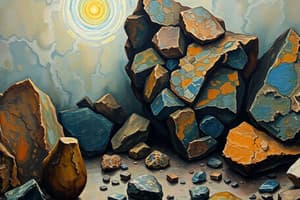Podcast
Questions and Answers
What is the difference between fluorescence and phosphorescence in minerals?
What is the difference between fluorescence and phosphorescence in minerals?
- Fluorescence occurs after the light source is removed, while phosphorescence occurs while illuminated.
- Fluorescence is the emission of light at the same wavelength, while phosphorescence occurs at a longer wavelength.
- Fluorescence represents lower energy transitions, while phosphorescence represents higher energy transitions.
- Fluorescence is temporary and only occurs during illumination, while phosphorescence continues after the light source is removed. (correct)
Which property of a mineral is considered more reliable for identification than the mineral's external color?
Which property of a mineral is considered more reliable for identification than the mineral's external color?
- Odour
- Luminescence
- Streak (correct)
- Habit
Which of the following is NOT a recognized mineral habit?
Which of the following is NOT a recognized mineral habit?
- Massive
- Translucent (correct)
- Fibrous
- Columnar
What is the primary reason most minerals do not possess noticeable odors in their natural state?
What is the primary reason most minerals do not possess noticeable odors in their natural state?
Which mineral property is characterized by the ability to conduct electricity or not?
Which mineral property is characterized by the ability to conduct electricity or not?
What type of habit describes a mineral that forms long, threadlike crystals?
What type of habit describes a mineral that forms long, threadlike crystals?
Which of the following minerals is known for having good electrical conductivity?
Which of the following minerals is known for having good electrical conductivity?
Which statement about mineral properties is accurate?
Which statement about mineral properties is accurate?
Flashcards
Streak of a Mineral
Streak of a Mineral
The color of a mineral's powder when rubbed against an unglazed porcelain plate. Streak helps identify minerals, even if their external color varies.
Luminescence
Luminescence
Minerals that absorb electromagnetic radiation and re-emit light at a different wavelength. This usually manifests as fluorescence during illumination or phosphorescence after the light source is gone.
Mineral Habit
Mineral Habit
The general shape or form of a crystal or crystal cluster. It is determined by the mineral's growth conditions.
Electrical Conductivity in Minerals
Electrical Conductivity in Minerals
Signup and view all the flashcards
Electrical Insulator
Electrical Insulator
Signup and view all the flashcards
Piezoelectricity
Piezoelectricity
Signup and view all the flashcards
Pyroelectricity
Pyroelectricity
Signup and view all the flashcards
Phosphorescence
Phosphorescence
Signup and view all the flashcards
Fluorescence
Fluorescence
Signup and view all the flashcards
Study Notes
Physical Properties of Minerals
-
Luminescence: Minerals exhibit luminescence when absorbing electromagnetic radiation (like UV light) and re-emitting light at a different wavelength. Fluorescence (light during illumination) and phosphorescence (light after illumination) are types of luminescence. Different minerals show different luminescence colors and intensities due to their composition and structure.
-
Streak: Streak is the color of a mineral's powder when scratched on an unglazed porcelain plate. It can be the same or different from the mineral's external color. Streak is consistent for a given mineral, regardless of variations in crystal size or color. It aids in mineral identification.
-
Habit: Mineral habit describes the general shape of a mineral crystal or cluster. It varies with formation conditions. Common habits include:
- Crystalline: Well-formed, regular geometric shapes (e.g., cubes, prisms, octahedrons).
- Massive: No discernible crystal shape; the mineral is compact, blocky, or granular.
- Fibrous: Long, thread-like crystals.
- Acicular: Needle-like crystals.
- Columnar: Pillar-like crystals.
- Granular: Small, interlocking crystals or grains.
Odour
- Minerals usually have no significant or noticeable odor in their natural state. This is because minerals are largely inorganic and not typically associated with volatile compounds creating smells.
Electrical Properties
- Some minerals exhibit electrical conductivity, a measure of how easily electric current flows. This depends on the mineral's structure and chemistry. Minerals with free-moving ions or electrons tend to be conductive. Examples include graphite (good conductor) and various sulfides (variable conductivity).
- Other minerals are insulators, not easily conducting electricity. Many oxides and carbonates are insulators.
- Electrical conductivity differs from piezoelectric or pyroelectric properties. These involve electricity generated by mechanical stress (piezoelectricity) or temperature change (pyroelectricity), but not a constant current flow.
Studying That Suits You
Use AI to generate personalized quizzes and flashcards to suit your learning preferences.




